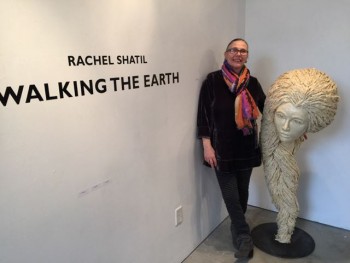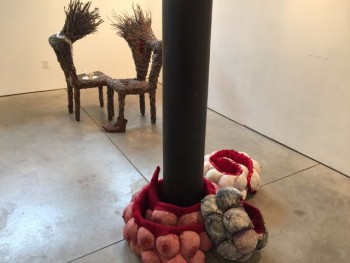
Rachel Shatil
Rachel Shatil grew up on a kibbutz in Israel. Both of her parents were holocaust survivors. “Life lessons were all about staying alive–not about ambition, career, art, finding love,” she said. “Love was careful, very guarded, because anyone you loved could be taken away.”
Fifty percent of the the people living on the kibbutz were holocaust survivors. “They lost mothers, fathers, cousins, entire families.” Most of the members of the kibbutz did not tell stories. “They did not want to poison the younger generation.” But her mother did tell stories. “And the stories she told about the holocaust were huge. Enormous. A long list of deaths. Something bigger than we could possible imagine. We children were told we could not understand it. Of course, we couldn’t. And still can’t.”
Her installation, on view at Galatea Fine Art Gallery in SOWA, “Walking the Earth,” is not an exhibit about the holocaust, or about being a survivor but rather about the imprint ghosts of the past leave on the banal daily activities of the artist’s life: her life. The sculptures are political, baring the artist’s relationship with family, country, place, and the residual trauma of genocide.

Chairs and Breasts
She uses quotidian material– shoes, coats,brassieres, hair, masking tape, plates and builds them into structures, some larger than life, other’s minimized. For example the house attached to a coat is the size of a doll house. “As a child, I never had a house.” Shatil ‘s home was the children’s house, shared with all of the other children in the kibbutz. “The only thing in the kibbutz that was mine, were my parents. My parents had lost their houses. It always felt like a home is something that can be easily lost.”
As a child she was a curious, always listening, and inherited the role of storyteller. Her art is narrative. Ideas for sculptures come spontaneously and then go through a process before realization. “ I define the metaphor, which is born in the world of words someplace between poetry and prose. Writing about the idea allows me to experience the metaphor that I am holding inside.” Only after Shatil understands the metaphor, does she begin.
“I am completely aware of my visual philosophy,” she said. I am a visual storyteller.”

Shatil with her Ballet Dancer sculpture
The Ballet Dancer, in the left rear of the installation, was sculpted in response to a memory of a specific survivor. “It is an visual encounter with a very delicate person who was thrown into a brutal situation.” The sculpture relies on a strong support frame. Over the support hangs a pink lace ballerina tutu. The torso of the dancer is knifed with shards of brown bark. Bark on a tree is protection, here is destruction, yet the blades do not penetrate the heart.
The dancer is both a real person, who she never met outside a story, and an aspect of herself. ”Characters stick. I collect them. I transfer myself into someone else.”
Shatil is a member of Atlantic Works Gallery. She showed the Ballet Dancer in 2015 New Member Show.
Rachel Shatil: Walking the Earth. Galatea Fine Art Gallery in SOWA, 460 Harrison Ave, Boston. January 2-31, 2016. 617-542-1500
